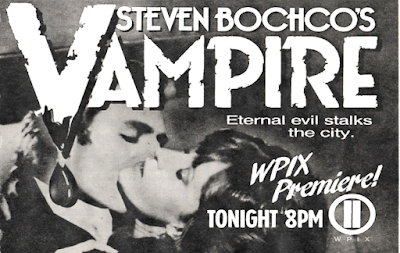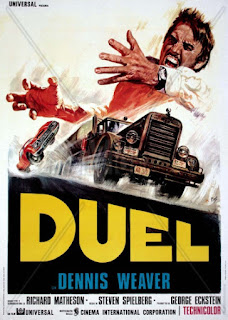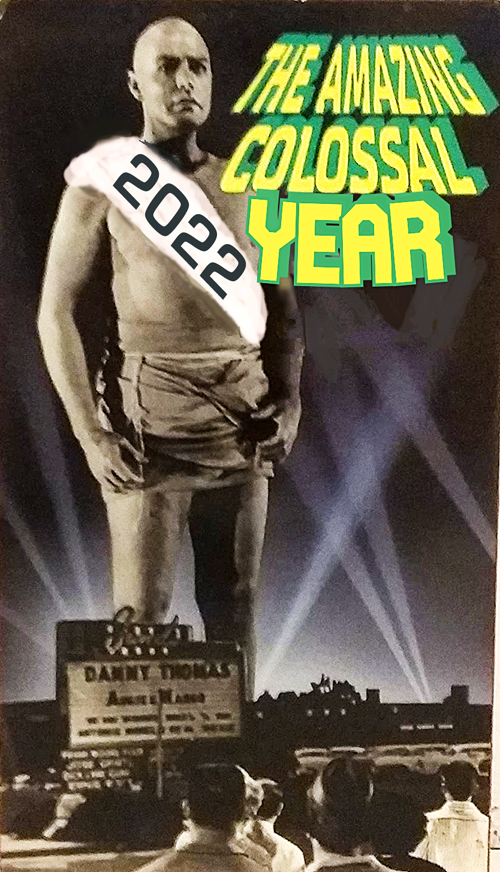Pros: Solid cast of familiar ‘70s character actors led by Andy Griffith as a no-nonsense small town policeman
Cons: Drags in places; Some of the action scenes fall flat
This post is part of the Odd or Even Blogathon, stylishly hosted by bloggers Rebecca at Taking Up Room and Gill at Realweegiemidget Reviews. Participants were asked to come up with two possibilities for a movie or TV episode to review, one released on an odd year and one on an even year. A coin flip determined which one got the green light -- heads for the odd year and tails for even.
With Old Man Winter settling in, I selected two chilling TV movies full of ice, snow and … death: A Cold Night’s Death from 1973, featuring a bizarre mystery at a polar research station, and Winter Kill from 1974, about a rural police chief dealing with serial murders at a ski resort. I’m told the coin toss came up tails, so Winter Kill it is! (Who knows, maybe I’ll review A Cold Night’s Death sometime before winter is over.)
First, a bit of housekeeping. Winter Kill the TV movie should not be confused with Winter Kills, a 1979 thriller/black comedy about an impenetrable conspiracy surrounding the assassination of a John F. Kennedy-esque president. Winter Kills, starring Jeff Bridges and John Huston, has a modern Alice in Wonderland feel to it, and there are all kinds of strange backstories attached to the production, but that’s a story for another time.
Winter Kill stars Andy Griffith as Sam McNeill, the police chief of Eagle Lake, a mountain resort town. We’re not in Mayberry anymore, as the film wastes no time getting down to murderous business. In the middle of the night, a stealthy figure dressed in a bulky winter coat and ski mask and carrying a shotgun sneaks up to a luxurious cabin in the woods. The figure throws snowballs at a picture window until the sleeping woman inside is awakened. When the woman pauses momentarily at the window, she’s cut down by a shotgun blast. The killer spray paints “The First” into the snow outside the cabin and steals away.
 |
| Ski mask: $12.95. Insulated winter coat: $85.99. Shotgun: $749.99. Revenge served cold: Priceless. |
Even before the murder has been discovered, Sam’s day is off to a bad start when he discovers that the welcome sign just outside of town has been defaced, with the word “Death” spray painted over “Eagle” of Eagle Lake, and a “?” added to the end of the population number.
Once Sam is at the murder scene and examines the message in the snow painted in the same bright red as the sign, it’s apparent that he’s got a cold-blooded killer with a demented sense of humor on his hands.
Suspicion immediately falls on the murdered woman’s wealthy land developer husband, Bill Carter (Tim O’Connor). Sam discovers that Carter’s wife was having an affair with a ski instructor (Nick Nolte) and the husband knew about it. Even more suspiciously, Carter’s shotgun is missing and the only story he can come up with is that he threw it in the lake in frustration after a disappointing hunting trip.
The coup-de-grace comes when the ski instructor is shot while making a run down the slopes, and “The Second” is found painted in the snow nearby. Carter is just a little too convenient a suspect, and when a third murder occurs -- a pastor is gunned down in his own church -- it’s apparent that the new victim has no connection to the love triangle.
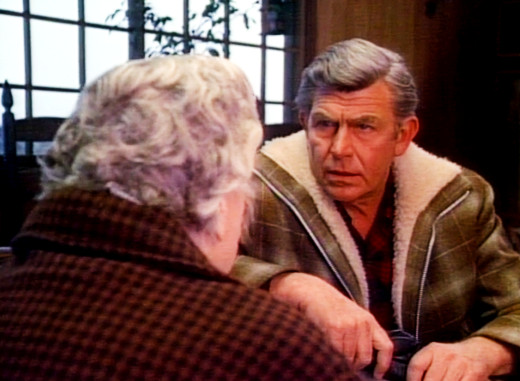 |
| "Ha! You blinked first!" |
From the get-go, the viewer is treated to clues to the killer's motive, as he/she is shown reading the diary of a young woman. Flashbacks progressively fill-in her sad story of falling in love with the ski instructor, getting pregnant, getting jilted and feeling that she was being mistreated by everyone around her.
Sam eventually figures out that the girl, Cynthia (Elayne Heilveil), is the connecting thread -- she was the daughter of the Carters’ maid, and had stayed with the couple for a year before mysteriously disappearing.
Now Sam must figure out why the people who interacted with Cynthia before she disappeared are being murdered. The investigation cuts too close to home when Sam finds out that his girlfriend Betty (Sheree North) was one of those people.
Despite the superficial similarities to The Andy Griffith Show -- the rural small town locale and colorful locals who all know one another -- Sam McNeill is no laid-back, avuncular Andy Taylor. He is all-business and not afraid to read the riot act to his bosses when they overstep.
Just a year before Jaws would portray civic leaders as greedy lunkheads willing to gamble with lives in order to protect the tourist trade, Winter Kill featured its own civics lesson. After the third person is killed, Sam is summoned to appear before the town council.
The anxious men are worried that the tourists will stop coming, and make it clear they’re losing faith in their police chief. The mayor informs Sam that “we hired you, and we can fire you,” and that they’ve decided to form a posse to hunt down the killer. Sam is having none of it:
“Whether any of you in this room believe it, I’m madder and more frustrated than all of you put together, but I’ll not run screaming down main street for you. And I’ll not allow any amateur policeman in this town to take the law into his own hands. And if any one of you tries it, I’ll squash you!”
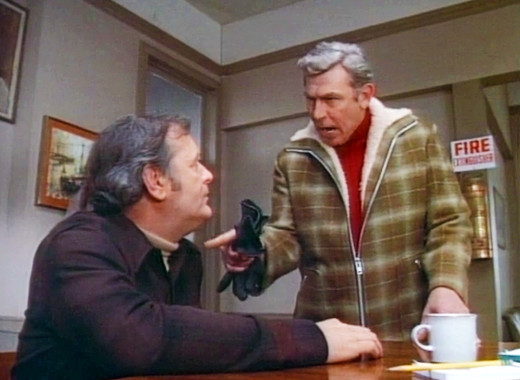 |
| Sam reads the riot act to the mayor (Eugene Roche). |
This is not good ol’ Andy Taylor of Mayberry talking. The only thing missing is the mic drop as Sam leaves the men sitting in embarrassed silence.
Winter Kill, which was intended as a pilot for a TV series, was produced by Andy Griffith Enterprises in association with MGM Television. It’s interesting that Griffith chose to play an almost mirror image of Andy Taylor in a much darker universe. The part still fits him like an old shoe, but it also seems like an attempt to update the too-good-to-be-true Andy image of the ‘60s.
ABC, which broadcast Winter Kill, went ahead and developed it into a series in 1975, renaming Griffith’s character. But either the network executives or audiences balked at the "new" Andy Griffith, as Adams of Eagle Lake lasted only two episodes.
Although Nick Nolte had very little screen time in Winter Kill, he made a good enough impression that he was cast as one of Sam Adams’ deputies in the series. Just a couple of years later, Nolte vaulted into superstardom playing Tom Jordache in the Rich Man, Poor Man mini-series. Griffith would have to wait another decade before his big TV comeback with Matlock.
The murders in Winter Kill are done with a shotgun, which is loud and messy and more disgusting than scary as a way to kill someone. The movie tries to compensate by showing each murder in Peckinpah-style slow motion, but that just comes off as cheesy. However, Winter Kill generates some real suspense at the climax when Sam chases down one last red-herring, unwittingly leaving Betty a sitting duck for the real killer.
 |
| Betty (Sheree North) has to fend for herself while her boyfriend is off on a wild goose chase. |
The movie’s biggest strength is Andy Griffith’s sober portrayal of a man under extreme pressure, trying to catch a cold-blooded killer while simultaneously navigating local politics and calming the townspeople’s fears. And then there’s the fun in trying to guess, along with Sam, who among the colorful residents of Mayberry, er, Eagle Lake, is capable of gunning down friends and neighbors in such a brutal fashion.
The line-up of suspects amounts to a sort of who’s who of ‘70s character actors: Tim O’Connor as Bill Carter the land developer; Lawrence Pressman as a browbeaten lawyer; Eugene Roche as the fidgety mayor; and Charles Tyner as Charley the amiable mailman, among others. If you’ve watched any ‘70s TV, there are more familiar faces than you can point a shotgun at.
Winter Kill is a solid, well-acted mystery-thriller that takes its time with local color and characters while gradually building suspense. The wintry vistas of the shooting locations, Big Bear and Snow Valley in California, provide a beautiful backdrop. It may be a bit too slow for some tastes, but it’s not a bad winter’s stroll down memory lane.


